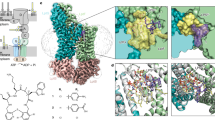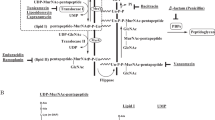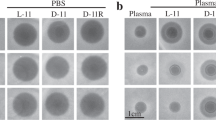Abstract
Although there is a need for antibacterial agents that act only on Gram-negative bacteria, there are at present few such compounds. The 2-deoxy analogue of β-KDO (3-deoxy-β-D-manno-2-octulopyranosonic acid) is a potent inhibitor of a key enzyme (CMP-KDO synthetase) in lipopolysaccharide biosynthesis of Gram-negative bacteria, but it fails to penetrate intact bacteria1. Coupling an L-L-dipeptide to the 8-amino-2,8-dideoxy analogue of β-KDO enabled it to be recognized and actively accumulated by certain peptide permeases of the cytoplasmic membrane. The dipeptide was hydrolysed in the cell and the inhibitor released. Subsequent inhibition of CMP-KDO synthetase led to the accumulation of large amounts of lipid A precursor and bacterial death. These compounds represent a new class of synthetic antimicrobials with a novel mechanism of action and considerable potential as chemotherapeutic agents.
This is a preview of subscription content, access via your institution
Access options
Subscribe to this journal
Receive 51 print issues and online access
$199.00 per year
only $3.90 per issue
Buy this article
- Purchase on Springer Link
- Instant access to full article PDF
Prices may be subject to local taxes which are calculated during checkout
Similar content being viewed by others
References
1. Claesson, A., Luthman, K., Gustafsson, K. & Bondesson, G. Biochem. biophys. Res. Commun. 143, 1063–1068 (1987).
2. Hammond, S. M. in The Bacterial Cell Surface (eds Hammond, S. M., Lambert, P. A. & Rycroft, A. N.) 57–82 (Groom Helm, London, 1984).
3. Osborn, M. J. in The Bacterial Outer Membrane (ed. Inouye, M.) 15–34 (Wiley, New York, 1979).
4. Hogenauer, G. & Woisetschalger, M. Nature 293, 662–664 (1981).
5. Rick, D. & Osborn, M. J. Proc. natn. Acad. Sci. U.S.A. 69, 3756–3760 (1972).
6. Ghalambor, M. A. & Heath, E. C. J. biol. Chem. 241, 3216–3221 (1966).
7. Fickel, T. E. & Gilvarg, C. Nature 241, 161–163 (1973).
8. Ames, B. N. et al. Proc. natn. Acad. Sci. U.S.A. 70, 456–458 (1973).
9. Ringrose, P. S. in The Scientific Basis of Antimicrobial Chemotherapy (eds Greenwood, D. & O'Grady, F.) 219–281 (Cambridge University Press, 1985).
10. Berges, D. A. et al. J. med. Chem. 29, 89–95 (1986).
11. Hemsdorf, C. L. & Simmons, C. in Microorganisms and Nitrogen Sources (ed. Payne, J. W.) 301–333 (Wiley, New York, 1980).
12. Gibson, M. M., Price, M. & Higgins, C. F. /. Bact. 160, 122–130 (1984).
13. Higgins, C. F. & Gibson, M. M. Meth. Enzym. 125, 365–377 (1986).
14. Payne, J. W. Biochem. Soc. Trans. 11, 794–797 (1983).
15. Rick, P. D., Fung, W–M., Ho, C. & Osborn, M. J. J. biol. Chem. 252, 4904–4912 (1977).
16. Rick, P. D. & Young, D. A. J. Bact. 150, 456–464 (1982).
17. Raetz, C. R. H., Purcell, S., Meyer, M. V., Quershi, N. & Takayama, K. J. biol. Chem. 260, 16080–16088 (1985).
Author information
Authors and Affiliations
Rights and permissions
About this article
Cite this article
Hammond, S., Claesson, A., Jansson, A. et al. A new class of synthetic antibacterials acting on lipopolysaccharide biosynthesis. Nature 327, 730–732 (1987). https://doi.org/10.1038/327730a0
Received:
Accepted:
Issue Date:
DOI: https://doi.org/10.1038/327730a0
This article is cited by
-
Carrier-mediated cellular uptake of pharmaceutical drugs: an exception or the rule?
Nature Reviews Drug Discovery (2008)
-
Emerging themes in medicinal glycoscience
Nature Biotechnology (2000)
-
The role of water in sequence-independent ligand binding by an oligopeptide transporter protein
Nature Structural Biology (1996)
Comments
By submitting a comment you agree to abide by our Terms and Community Guidelines. If you find something abusive or that does not comply with our terms or guidelines please flag it as inappropriate.



